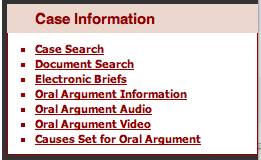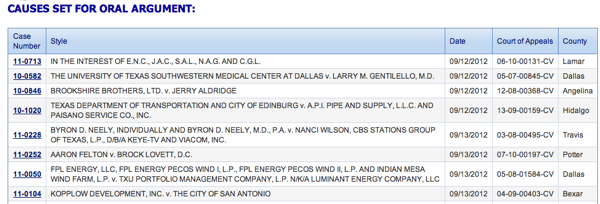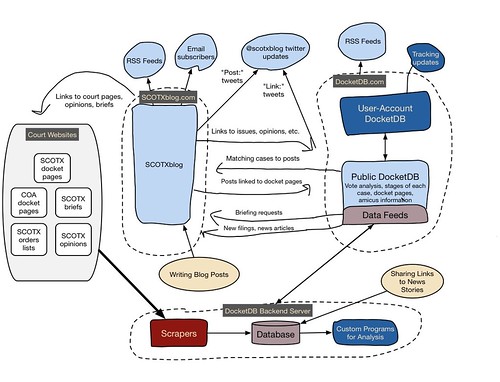Category: 'Legal Tech'
June 18th, 2013 · Comments Off on “Putting the ‘App’ in Appellate Practice”
That was the title of a panel that I was asked to participate in last week at UT’s Conference on State and Federal Appeals here in Austin.
The other two panelists were Blake Hawthorne (the Clerk of the Supreme Court of Texas) and Rich Phillips (of Thompson & Knight). We spoke about some practical ways to use an iPad to get actual (and, yes, even billable) appellate work done.
Blake focused on ways to read and annotate PDFs, a topic of particular interest to judges adapting to Texas’s new e-filing system. Rich focused on ways to work with appellate records and do legal research. And I focused on how to use the iPad as part of the writing process.
Our presentation included live demonstrations and some video captures of using the iPad. The version below does not have either, but we have included a few screenshots to give you a flavor of what we discussed.
Find out more:
-
Download the full slidedeck.
-
Download the conference paper for this talk, which lists some of the apps we discussed.
Tags: Legal Tech · Practice Notes
March 8th, 2013 · Comments Off on SCOTX clarifies the word count rule
I was puzzled the first time I saw opposing counsel attach a formal word-count certificate to a very simple one-page letter to a court. No word limits apply to those letters. (Don’t get any ideas!) So, why would that be required?
His reasoning was that the governing rule was a little unclear about what was required. At that time, it said “A computer-generated document must include a certificate … stating the number of words…” So, thinking like a good appellate lawyer, my opposing counsel included a certificate on all filed documents as a matter of course.
This week, the Texas Supreme Court has clarified the rule. Its short set of amendments to the word count rules now specifies that only those documents that are actually “subject to a word limit” need attach a certificate of compliance.
Tags: Electronic Briefs
July 18th, 2012 · Comments Off on The new TAMES search window is online

This week the Court has rolled out the first public part of the TAMES system, its docket pages and the search window you use to reach them.
The new format for docket pages includes electronic versions of motions and orders, as well as an impressive amount of detail about things like which dates attorneys are listing on vacation letters. (( I don’t think there will be a Please Rob Me competitor for Texas attorneys, but you never know. ))
The case search window allows you to filter by characteristics such as county, court of appeals, or even attorney name. Let the vanity searches begin…
The window includes an option to “Exclude Inactive Cases.” Based on some poking around, it looks like TAMES draws that line exactly where DocketDB does — when a case file has been closed and stored.
A glimpse of things to come is at the bottom of this new menu, with an option to see “Causes Set for Oral Argument.” The page displays a list of upcoming arguments, linked back to the Court’s docket information.

Tags: Legal Tech · News and Links
July 9th, 2012 · Comments Off on Some upcoming construction on the blog (and an update on DocketDB)
SCOTXblog will be undergoing some major construction this summer.
The timing is driven by the imminent launch of TAMES in the Texas Supreme Court. The Houston courts have already launched the system, and so I have a better sense of how these changes will affect the websites that I’ve built to follow the Court.
As you’d expect, I will be watching the TAMES rollout as closely as anyone. It will include many of the features I built for DocketDB — along with some others that no one outside of the courts themselves could have implemented (like copies of motions and letters).
They call the internet a “web” for a reason
Here’s a rough sketch of how my Texas court-watching projects fit together:

On this chart, the blog you’re reading is near the middle. My personal court-tracking database is at the bottom, and you can see how some of those connections flow through to public sites (like the blog or the public areas of DocketDB).
As crazy as this chart looks, it seems to work. Some of the scrapers have been running for more than five years with very little modification.
The future of DocketDB and SCOTXblog
While TAMES is a great deal for the public, it has a cost for me. My private court-tracking system is built on a foundation of “scrapers”, tuned to understand the old website. When the new site goes live, the Court’s docket information will be shifted to new pages and put in new formats. The existing scrapers will not know how to find or work with this information, so data will stop flowing into my private database, which in turn will freeze the public version of DocketDB. (( This has happened on a smaller scale at various times this spring, as the Court has made small improvements to its website. Even tiny changes on the Texas Supreme Court website — such as putting the description for a particular kind of docket-sheet entry into plainer language — confuses the scrapers. I’ve been able to make small fixes as these have come to my attention. The TAMES rollout will be an order of magnitude (or two) more complex. ))
For that reason, I anticipate that the public version of DocketDB (including registered accounts) will also wind down soon after the Court switches over to TAMES. That site needs a consistent flow of accurate data, and I won’t have that until I build a new set of scrapers for my own tracking system.
My first priority is fixing SCOTXblog. The easiest approach would be to cut the connections between the blog and my court-tracking software, leaving just a basic blog in place. But that’s not my style.
I’d much rather build a new platform for SCOTXblog that can better support the kind of case updates and articles that I’d like to write — and that, I hope, you’ll want to read.
I’ll update you as I make progress. In the meantime, you may see some longtime blog features start to disappear or stop working (like the feed of news articles or briefing requests). If you see something that looks more broken than usual, please let me know. And, of course, please stay tuned. I look forward to sharing the new site once it’s ready.
Tags: DocketDB · SCOTXblog Announcements
June 13th, 2012 · Comments Off on Majority of federal judges are (already) using iPads; Justice Guzman goes to summer school; Petty lawsuit over
Now a majority of federal judges are using iPads
Judge David Nuffer (District of Utah) wrote a guest post on 3 Geeks and a Law Blog with some thoughts about the use of iPads by his colleagues on the federal bench.
The post begins by citing a recent report that 58% of federal judges “use an iPad for their court work.” (( He notes that the percentage of federal bankruptcy judges using iPads is higher (70%), but he does not mention the percentage of federal appellate judges using them. I can’t locate the survey online to check. ))
Judge Nuffer explained that they “have replaced laptops for many judges.” In particular, they are used not only for email but also for reading PDFs filed through the e-filing system.
Most judges also use an iPad for general reading because electronically filed documents are all PDF format. Apps such as PDF Expert, iAnnotate and Goodreader work well with these PDF documents. The documents can be annotated while reading and the annotations persist when the document is returned to chambers storage servers. Judges appreciate the ability to take voluminous documents with them in the same device they use for email. This results in less printing of electronically filed papers.
This echoes some of what Texas practitioners heard at the UT appellate conference two weeks ago. In 2010, the theme across the judicial panels panels was “e-briefs.” This year, it was “iPads.” The panel of Texas Supreme Court Justices noted that they are using a variety of devices, including the iPads that they have been issued. At least some of Texas’s intermediate appellate courts have also bought iPads for the use of the judges. And the panel of federal Fifth Circuit judges also mentioned that some judges are starting to review the parties’ briefs on iPads in preparation for oral argument.
Justice Guzman goes to summer school
Justice Eva Guzman is among the enrollees in the inaugural class of Duke University’s Master of Laws in Judicial Studies degree program.
She was quoted in an article in The Herald-Sun about the new program and how it fits into the schedule of a working judge:
Committing to the program, explained Eva Guzman, a justice of the Texas Supreme Court, has required some juggling and some very full days.
“While you’re here, you have to keep up with your full-time job back home,” Guzman said. “After your classes and dinner, you then begin your second eight-hour job.”
According to this list of enrollees, the class also includes Justice Frost of Houston’s Fourteenth Court of Appeals.
Source: The Herald-Sun, “The judges take a seat”
The challenge to Justice Hecht’s ballot eligibility has been dropped
Michele Petty, who is the Democratic nominee to run against Justice Hecht in the fall election, has dropped her challenge to his ballot eligibility.
According to the Statesman article, Petty concluded that any technical defect in the petitions had not actually confused any of the voters:
In a motion to dismiss her lawsuit, Petty told the Travis County District Court that her investigation revealed that voters “understood what they were doing” when they signed the petitions.
“Petty felt it would not be fair to invalidate their signatures because of error on the part of the circulators or notary,” said the filing.
In the filing, Petty also encourages the Legislature to revisit the requirement that judicial candidates solicit these signatures at all. Currently, state law requires potential judicial candidates who would run as Republicans or Democrats to obtain 50 signatures from each of Texas’s fourteen appellate districts. It does not impose the same requirements on third-party candidates.
Tags: Legal Tech · News and Links
December 1st, 2011 · 1 Comment
This seems as good a day as any to talk about the Justices’ output last Term.
We know how many signed opinions each Justice wrote as soon as they’re published. But the per curiam opinions are a mystery. It’s not until the Texas Office of Court Administration (OCA) releases its year-end report that we get a count of how many were credited to each Justice.
Now that OCA has released its report, I’ve updated my chart of opinion authors, which shows:
- Justice Hecht led the way with 27 deciding opinions — 15 signed and 12 per curiams.
-
Justice Johnson (19 deciding opinions) and Justice Wainwright (16 deciding opinions) also exceeded the Court’s average of slightly more than 12 per Justice. (Justice Medina and Chief Justice Jefferson were very close to that mark.)
-
The most frequent author of concurring opinions was Justice Willett with 7, almost half the Court’s output of 16 concurrences. Chief Justice Jefferson was a strong second with 4 concurrences.
-
The most frequent author of dissenting opinions was Justice Johnson with 6, closely followed by Justice Lehrmann with 5. Justice Wainwright also had 5, if you fold in opinions that were both “concurring and dissenting.” Every Justice authored at least one true dissenting opinion.
-
No Justice wrote more per curiams than signed majority opinions. Only Justice Hecht authored more per curiams than separate (concurring or dissenting) opinions. The focus was very much on clearing out the signed opinions from the Court’s docket.
These OCA statistics focus on opinion authorship — the traditional (albeit imperfect) measure of output for appellate judges.
We might soon have some new measures, thanks to recent legislative demands for details about how individual Justices have been meeting the Court’s internal deadlines. And as it turns out, those reports are due on December 1st of each year. (( You can find the language on page 3 of this very large PDF, part of the appropriations bill in 2009. ))
Tags: DocketDB · Practice Notes
August 12th, 2011 · 1 Comment
If you found this blog with the search term “Supreme Court blog” (which a surprising number do), you’re in special luck today.
I’ve been working on a project to track the U.S. Supreme Court, much like my DocketDB project tracks the Texas Supreme Court. The site is CertPool.com. I put a simple version of it online late last year, and I’ve made improvements as I had time. The process has been quiet. I’m not sure that I ever mentioned it on this blog, although it has been noticed by the Volokh Conspiracy, and then by Crime and Consequences blog and a handful of others.
Read more about CertPool.com
Tags: Legal Tech · US Supreme Court
I will not be posting about the Friday orders list this week or next. You are on your own until June 22nd, when I return to the blog.
As blog readers know, the Texas state appellate courts are shifting toward electronic briefs. Unlike the federal system, the Texas rules permit advocates to make use of hyperlinks and encourage the use of internal bookmarks to ease navigation. The focus is on making the briefs more useful to the ultimate readers — the judges and law clerks who will use them to decide cases and write appellate opinions.
Last Thursday, I gave a presentation about electronic briefs with Blake Hawthorne at the UT Conference on State and Federal Appeals. We covered quite a bit of ground for a thirty-minute talk — the basics of how to make these briefs, some survey results from judges and staff members who have been using them for the past year, and some clips of video interviews with Texas Supreme Court Justices on the same subject.
See the video interviews and get the slide deck
Tags: Electronic Briefs · News and Links · Practice Notes





